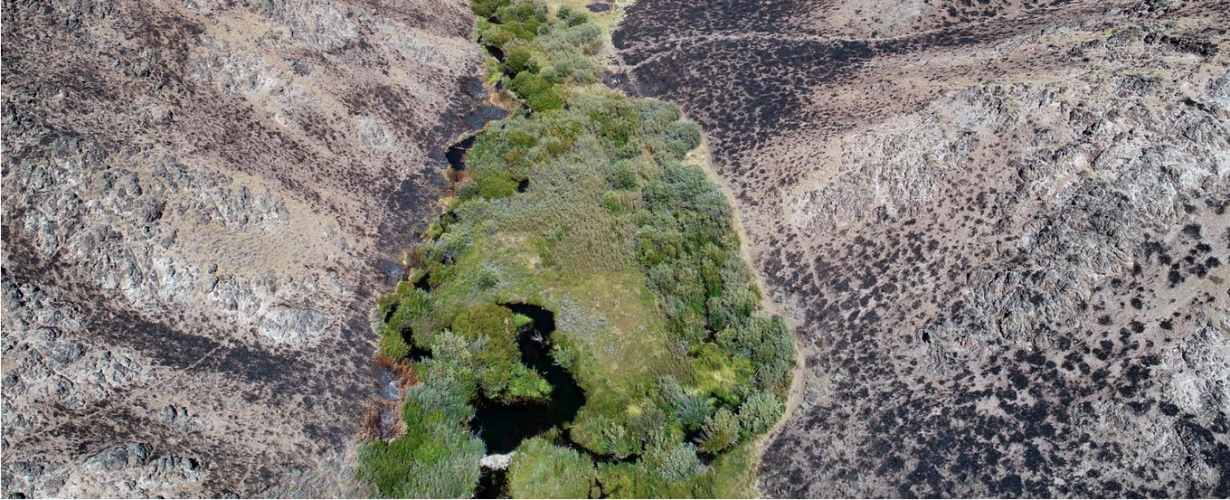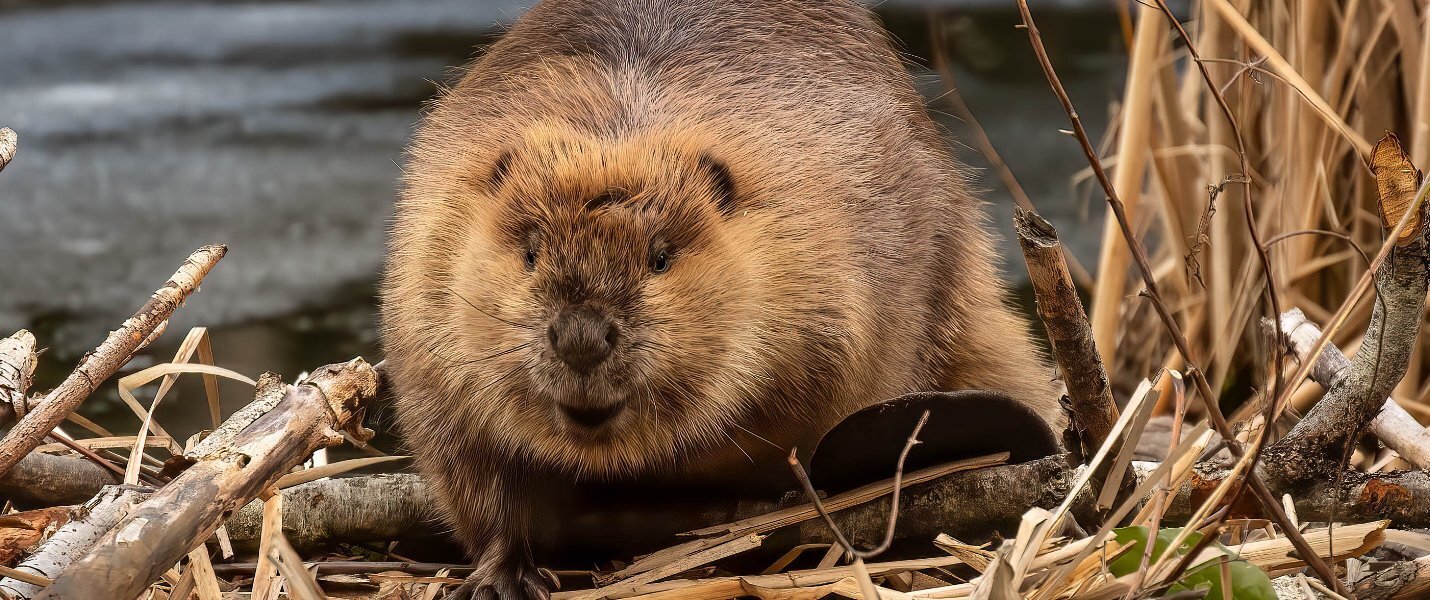Coexistence Brings Benefits
There are many ways to reap the benefits that beaver provide—while avoiding potential nuisance and costly, ineffective lethal management. Coexistence solutions are easy to implement, and land managers are already using these proven solutions throughout California to reduce the impacts of fire, flood, and drought.
“When we consider disaster preparedness for farmers and ranchers, we ask: ‘Where is your retreat zone?’ If there were a fire here in June and we still had cattle there, gates could be opened, and cattle could enter the wetted pasture/riparian area, and they should be safe from the fire. When beavers re-wet the floodplain, it can be a fire resilience strategy just as irrigated pasture.”
—Tracy Schohr, Rancher and UC Cooperative Extension Livestock & Natural Resource Advisor
Conflicts and Costs
Beaver are native to California and once provided benefits to watersheds throughout the region. But their dams, wetlands, and tree chewing can cause problems.
People often kill beaver, destroy dams, or manually unclog culverts to prevent floods and vegetation damage. These time-consuming methods are costly and ineffective in the long run. No matter how many beaver you kill, if the habitat is favorable and there are other colonies nearby, they will continue to return.
In California, the effectiveness of lethal management is questionable in comparison to more effective non-lethal coexistence strategies. In a recent comparative analysis, coexistence methods such as Pond Levelers and Culvert Protective Fences achieved 87% and 97% success rates respectively, whereas trapping yielded only a 16% success rate.

Beaver Benefits
When managed appropriately through coexistence strategies, beaver provide economic benefits through associated ecosystem services. The dam complexes, bank burrows, and canals beaver build have positive physical, chemical, and biological effects on the watershed. Studies indicate that beaver dams and associated ponds help mitigate the impacts of drought and wildfire by increasing surface water and groundwater storage, regulating flood waters, and creating what Dr. Emily Fairfax calls
“green ribbons of fire-resistant riparian corridor” (Fairfax and Whittle, 2020). These wetted areas can slow an active wildfire and serve as critical refugia for species to escape. Additionally, beaver dams improve water quality, repair eroded channels, and reconnect streams to their floodplains. By stabilizing stream flow and repairing floodplains, the work of beaver can mitigate the impacts of drought and flood, benefiting water managers, farmers, ranchers, and landowners.

By shaping waterways beaver
Mitigate Floods
- Dams on a creek or river can act as a buffer in high flows, reducing intensity of floods.
- Beaver dams slow and redirect flood waters across adjacent lowlands, encouraging riparian vegetation, which also works to accumulate new soils and hold existing soils in place.
- In severely incised or down-cut creeks, beaver dams can help bring the streambed up to its original level, reversing the effects of channel erosion.
Reduce Drought & Wildfire Impacts
- As beaver dams spread water out, creating wetter habitat, they promote subterranean recharge and the release of water later in the season. This can be immensely helpful in California’s Mediterranean climate where we experience prolonged droughts and do not receive rain during the hot summer and fall months.
- Beaver-managed wetlands create important buffers that are less prone to burn during wildfires. These aquatic refuges provide many animals with an escape during fires and intact habitat afterwards.
Improve Water Quality
- Studies show that wetlands created by beaver dams act as filters, trapping sediment, phosphorus, and other potential contaminants.
- In mountain watersheds, beaver dams can have even more influence on water quality than climate-driven, seasonal precipitation extremes. Dams raise water levels upstream, which divert water into surrounding soils and secondary waterways. These soils and side channels then filter out excess nutrients and contaminants before water re-enters the main channel downstream.
- One study showed that the beaver dams in Taylor Creek, which empties into the southern end of Lake Tahoe, help keep phosphorus from entering the lake.
- When an oil pipeline broke in northern Utah in 2013, beaver dams prevented diesel from reaching the fresh waters of Willard Bay.
Sequester Carbon
- Dam building keeps the sediment and soils of wetlands hydrated, preventing the carbon from drying out and releasing into the atmosphere.
- The carbon from the wood beaver use to make their dams is sequestered as well.
Create Habitat
- Recent research indicates that many of California’s native and endangered fish, such as coho salmon, steelhead trout, and Lahontan cutthroat trout, benefit greatly from the presence of beaver habitat modifications (dams, wetland complexes, canals, lodges, bank burrows, and submerged stick piles).
- These modifications provide fish with areas to escape from predators and high flows, while also providing access to a greater abundance of food sources. Unlike human-made dams, beaver dams are not a threat to fish passage.
- Beaver ponds provide excellent habitat for many different waterfowl and other birds, including the endangered willow flycatcher and least Bell’s vireo.
- Shallow wetlands or “fens” associated with beaver dams provide ideal breeding ground for amphibians, including the Cascades frog, which has been identified as a species of special concern.
- As beavers re-inundate critical meadow habitat, encroaching conifers are drowned out and become snags, which provide excellent nesting sites for woodpeckers, owls, and other cavity nesters.
- Beaver restoration can be an important tool to reclaim the historic footprint of critical wet meadows and riparian habitats.

Case Studies
These examples of successful projects demonstrate that coexistence solutions are affordable and easy-to-install. Land managers are already using these effective and proven techniques throughout California, saving time, reducing costs, and minimizing stress and strain on workers. Read the case studies below to learn how these methods might work for you.

Recognizing the ecological and economic value of keeping beaver in place, the California Department of Fish and Wildlife (CDFW) instituted a new policy in 2023 that supports non-lethal strategies when possible. Now, beaver coexistence is made even more affordable by the California Beaver Help Desk’s Financial Assistance Program. Apply for cost-sharing assistance!
